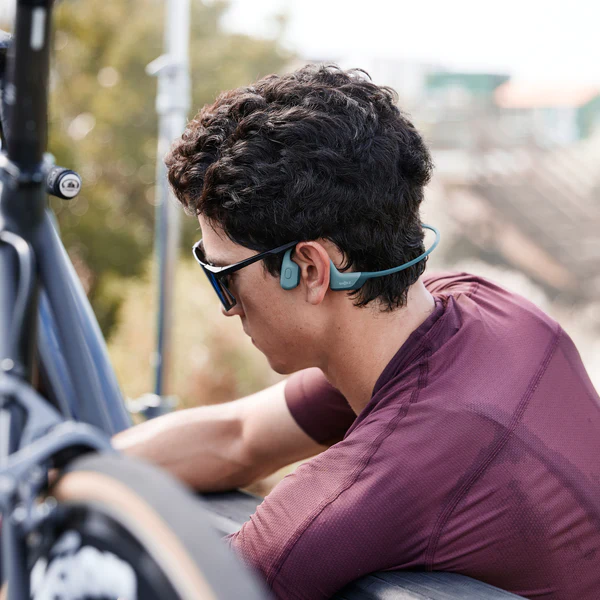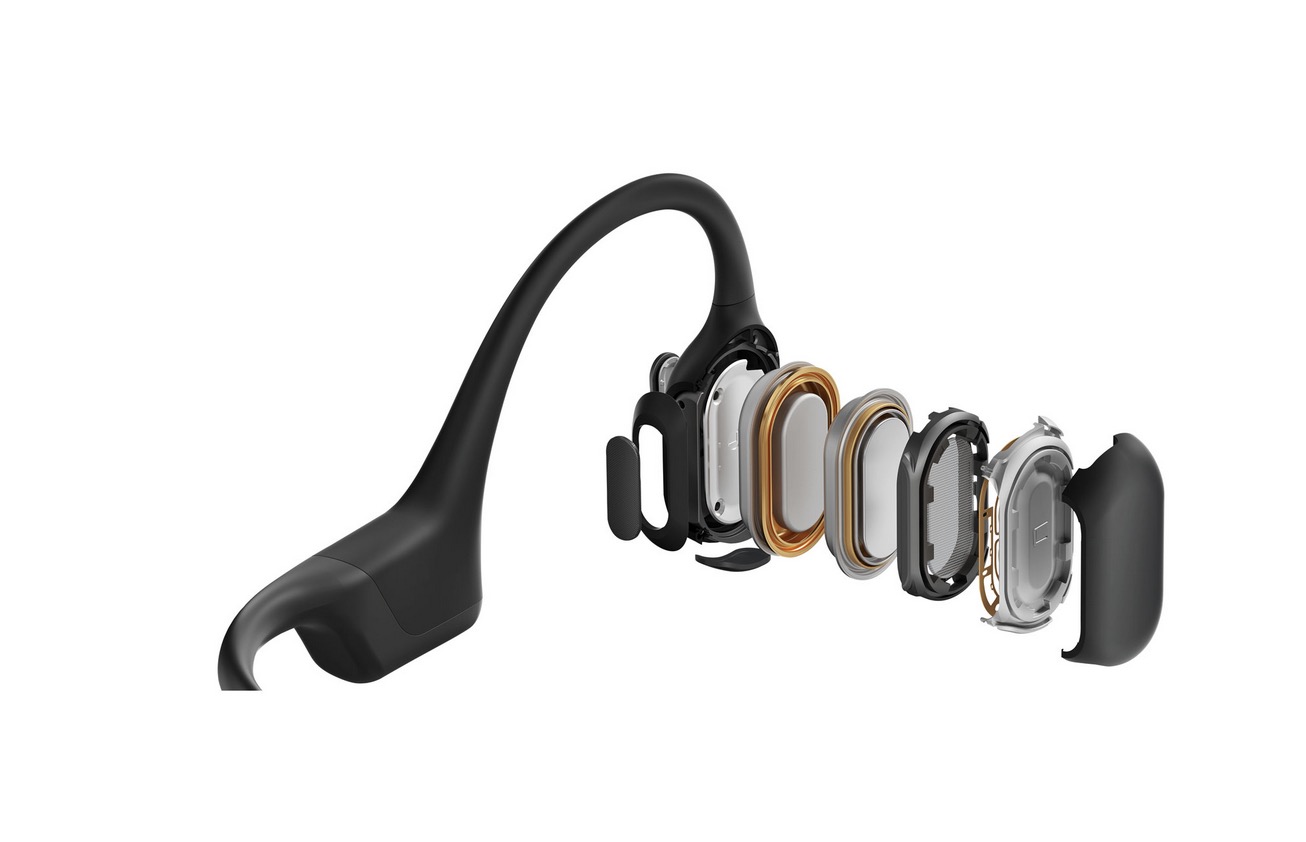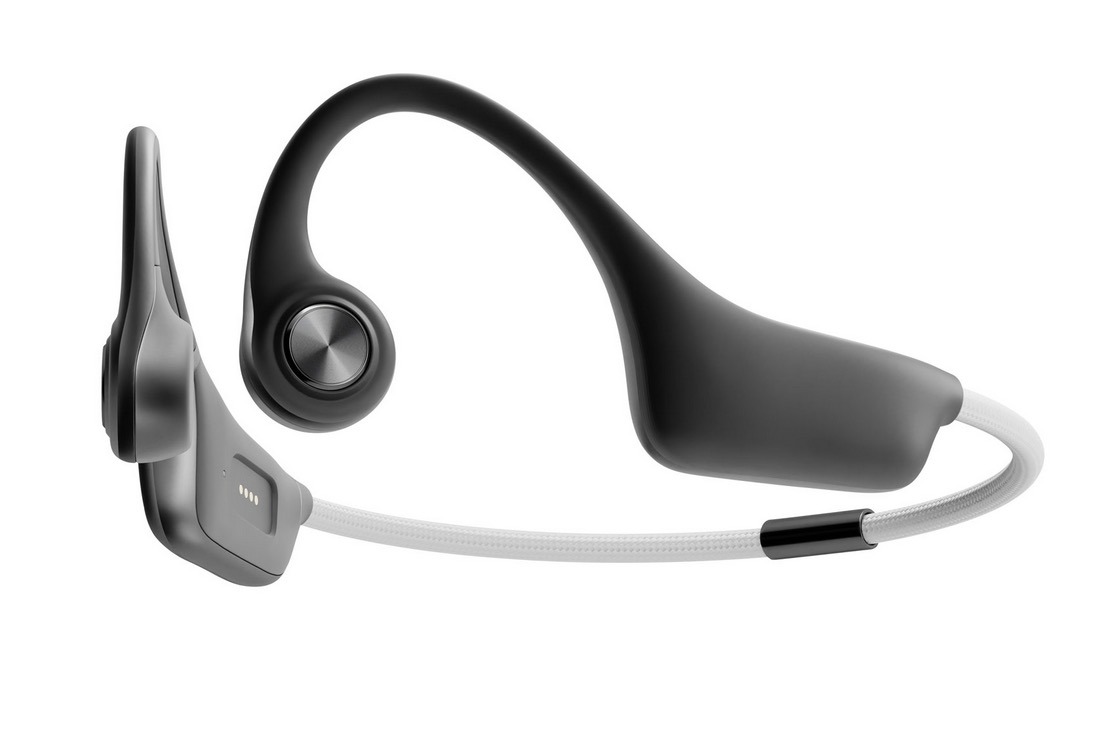
Bone conduction headphones are a type of open-ear headphones that use vibrations instead of air to transmit sound. The technology works by sending sound signals directly to the bones of the skull through vibrations. Almost like magic, bone conduction technology allows us to recognize an incredible symphony of frequencies from one of the most fragile bones in our body. Are open-ear earbuds better than the ‘normal’ headphones that use air? What scenarios are they useful in? Let’s take a deeper look into this miraculous tech.
What are bone conduction headphones?
Unlike traditional headphones or earphones, the transducer (or, speaker-like vibration device) in bone conduction headphones doesn’t move air within your ear canal, but quite literally shakes or vibrates the bones of your skull in barely perceptible ways. These vibrations are interpreted by the inner ear, so whoever is wearing the headphones can hear the sound without it being played ‘into’ the ear.
It sounds like it would be uncomfortable, but the effect is an even greater form of magical illusion, where your ears remain open to external sounds while the playback of audio from your portable device sounds like it’s literally emanating from inside your head.
Best uses for bone conduction headphones
Bone conduction headphones are most popular for two different types of activities—working out and sleeping.

1. Bone conduction headphones for working out
The advantages of open-ear headphones are clear for anyone who engages in athletic activities. For bicyclists, for example, bone conduction headphones let you play tunes while still being able to perceive other traffic noises. Even for regular, everyday listening the technology provides a more comfortable experience, one whereby simply placing one of the devices on your head treats you to sounds that are directed strictly towards you.
The design of bone conduction headphones also keeps them comfortable and secure during workouts. Unlike in-ear headphones that can bounce out or slip out when you get sweaty, bone conduction headphones sit outside your ear so you’ll hardly notice you’re wearing them. They also won’t hurt the ear canal during long sessions of listening because there are no buds pressing against the folds of your ears. They’re easy to clean too—because they don’t sit inside your ear they stay cleaner than other in-ear headphones or earbuds. When you’re done your workout you can just wipe them with a cloth and continue using them.
2. Bone conduction headphones for sleeping
Bone conduction headphones are a popular choice for sleeping because they are comfortable and they have a non-intrusive design. They rest outside of your ears and wrap around the back of your head so you don’t feel anything when you’re lying down. They are great headphones to pick if you’re a restless sleeper and flip into multiple positions during the night.
With open-ear earbuds, you can still hear ambient sound, which is nice if you want to stay aware of outside noise when you’re sleeping. However, if you want to completely cocoon yourself, you can still enjoy your sleep playlists as the sound is directed toward you and there is minimal sound leakage so you won’t disturb your sleeping partner.
3. Bone conduction headphones for hearing loss
Perhaps an under-reported advantage of this technology is how these headphones can work for those with certain hearing impairments. Because bone conduction bypasses certain parts of the ear, some hearing impaired users will still be able to enjoy full audio augmentation. There are even those with certain types of hearing aid that can enjoy music again thanks to this remarkable technology.
Sound quality of bone conduction headphones

It’s the sense of situational awareness that gives bone conduction headphones the greatest benefit over more conventional earphones, but that’s not to say you have to skimp on sound quality.
Thanks to advances in true wireless technology, bone conduction models are truly freed from the tangles of cords required in the past. What may be more surprising than the wireless design is just how good they can sound. While they may not rival the best in-ear or circumaural models, it seems almost like science fiction how bone conduction headphones are able to sound so good using a totally different mode of transmission.
On these headphones you’re likely to get a small tickling sensation with bass-heavy tracks—after all, these are essentially vibrating pads transmitting through your skull—so those with sensitive skin may need more time to get used to the sensation. Yet the sound quality, especially on the higher end models, does actually rival many conventional devices, with the added benefit of safety and comfort.
Brands that design bone conduction headphones

There are several manufacturers of bone conduction headphones, but one of the most respected is Shokz. For over a decade, they have been pioneers in bone conduction technology. Like several of their competitors, Shokz has a range of devices that fit your budget, from the affordable OpenMove set for regular, comfortable listening to the more robust and securely fastened OpenRun. They also have their most highly capable OpenRun Pro model. All these models share a similar waterproof rating, making them perfect for active use both outdoor and indoors, no matter how wet and sweaty you plan on getting.
Sudio is another brand to keep an eye on in the bone conduction headphones space. They have the Sudio Audio B1 model, available in white and black, which has an IPX4 rating and up to 30 hours of battery life for workouts, sleeping, or casual listening.
Should you choose bone conduction headphones?
Bone conduction technology is now robust enough to compete with conventional headphones, and thanks to advances in the miniaturization of transducer components, batteries, and associated Bluetooth technologies, they’ve never been better. Whether you choose a model from Shokz, Sudio, or any other brand, if you’re looking for portable music playback that’s private while providing exceptional situational awareness, then bone conduction headphones are definitely worth actively seeking out. You can find them right now at Best Buy.






Hi Jason,
Great article!
They can also be used by people who prefer not to wear traditional headphones or earbuds, such as individuals who find them uncomfortable or experience ear canal blockage.
Regards
Comments are closed.